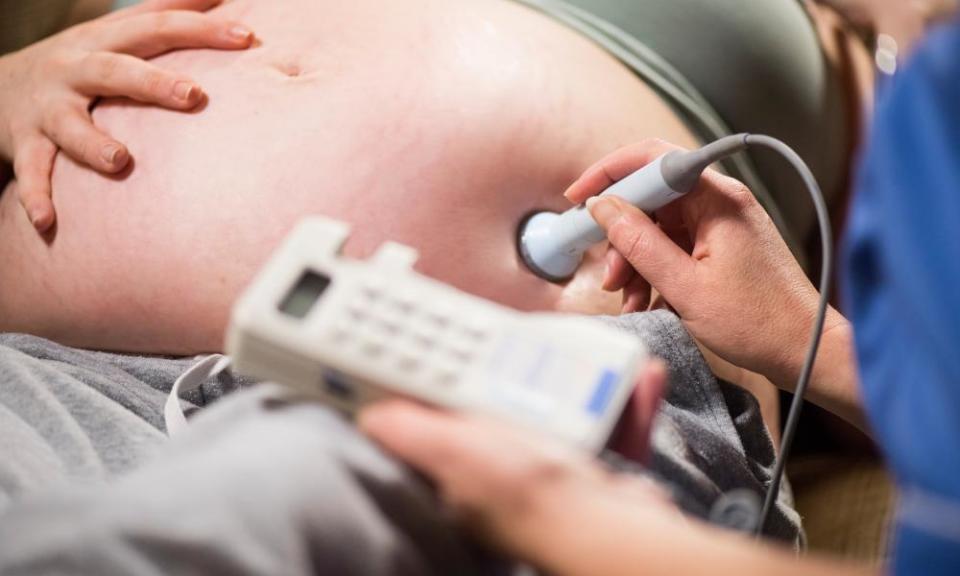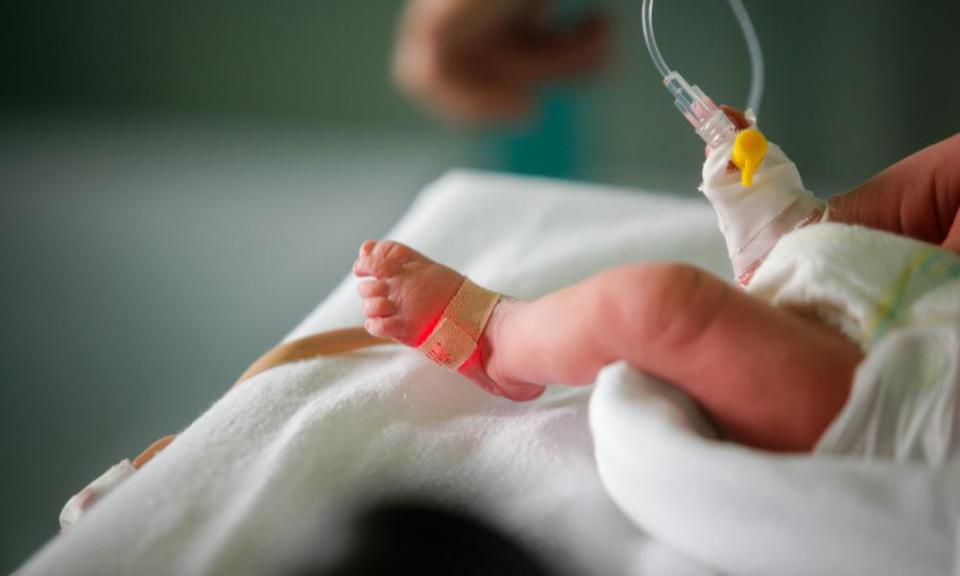Air grievances: silence swirls around the toll of bushfire smoke during pregnancy

Janet Frank describes her first miscarriage in August 2019 as “hectic”.
“There was a lot of bleeding and a lot of hospital visits,” Frank, not her real name, explains. She bled for two months and eventually had to have a surgical procedure to end the pregnancy.
Frank was trying to conceive by IVF and gave it another shot later that year, but miscarried again in January 2020 and then once more in April 2020.
The bushfire season of 2019-20, known as Black Summer, burned through 18.6m hectares of land and caused some of the worst bushfire smoke in living memory to descend on Sydney. Images of the city blanketed in a thick brown soupy haze were splashed across media around the world.
Related: Air pollution 'as bad as smoking in increasing risk of miscarriage'
When asked whether she would have gone for another two rounds of IVF if she’d known that the smog that descended on Sydney could have increased her risk of miscarriage, Frank responds without hesitating.
“The August miscarriage had been so physically taxing and traumatic … after that if someone had said to me, when [the smoke] was getting really bad that we could delay a couple of months, and if that had been combined with what my doctor loves to do which is just tell me to lose weight, I probably would have gone ‘Alright, I’ll use this time to lose weight, and I’ll try again’,” she says.
But despite being surrounded by medical professionals – the midwives, obstetricians, medical technicians and nurses who make IVF a reality – Frank wasn’t given any information about how to protect herself amid the environmental crisis or how it could potentially increase her risk factors.
In November, the Australian Institute of Health and Welfare released its report Australian bushfires 2019–20: exploring the short-term health impacts, but pregnancy was mentioned in the body of the report just twice.
The first mention acknowledged that pregnant women are one of the vulnerable groups in bushfires and the second simply said we needed more research to understand how bushfire smoke affects vulnerable groups. It noted that exposure to smoke in the second trimester, specifically that PM2.5 – a particulate matter that can cause inflammation and a raft of adverse health outcomes – has been positively associated with preterm birth.

While there are significant gaps in our understanding of how bushfire smoke and air pollution affect pregnancy, we know much more than what was noted. Enough to know that much more health messaging is urgently needed.
Professor Sarah Robertson is the director of the Robinson Research Institute in Adelaide. She is a biomedical scientist and has worked for 30 years on understanding the immunology of pregnancy and receptivity in maternal tissues.
“We clearly have got high and increasing rates of infertility, unexplained infertility and unexplained pregnancy loss, and increasing rates of gestational disorders like preterm birth and preeclampsia,” explains Robertson.
While we don’t know the degree to which pollutants are affecting these rates, we do know they have a significant role to play and that the area needs more research.
“We used to think in Australia that environmental toxins were probably a minor contributing factor, but I think we can now confidently say that … the data is progressively building, and the biology is stacking up, to point to them being a more important driver of reproductive and pregnancy health than we thought 10 years ago,” she says.
Two studies have linked air pollutants to miscarriage rates. The first in China made a quantitative association between ambient air pollution exposure and pregnancy loss in the first trimester. The second, an American study conducted in Salt Lake City in Utah, found that a 20 microgram per cubic metre (µg/m3) increase in nitrogen dioxide (NO2) resulted in a 16% increase in risk of miscarriage.
According to data provided to Guardian Australia by the New South Wales Department of Planning, Industry and Environment, during the 2019-20 bushfire season, NO2 levels in Sydney’s CBD went from about 84.6 µg/m3 in winter to 206.8 µg/m3 at its bushfire peak.
In Parramatta, the levels went from 107.16 µg/m3 in winter to hit a peak of 131.6 µg/m3 during the bushfires.
Air pollutants can also change DNA methylation, which is an epigenetic alteration of our DNA, meaning they can change the way our DNA behaves without changing the DNA sequence.
Associate Prof Jeff Craig is a lecturer in medical sciences at Deakin University, and studies the role of epigenetics in mediating the effects of early life environment on the risk for chronic disease.
“If you imagine that the genes are like musical instruments, epigenetics are like the musicians who play the instruments, because they can’t play themselves,” he explains, using a metaphor developed by the journal Nature.
“Together, they play the symphony of life on the genes. Epigenetics is literally on top of DNA and epigenetics, like the musician, controls how the gene works, almost literally ‘play’ the gene, and epigenetics governs development.”
Fine particle air pollution – like PM2.5 and PM10, which we heard so much about during the bushfire season – can cause changes in DNA methylation, which could affect placental and foetal development.
Particle matter can be made up of pretty much any of the components you can find in air pollution, including nitrates, sulfates, organic chemicals, metals, soil or dust particles, as well as allergens like pollen or mould spores. During bushfire events, particle matter reaches extremely high concentrations and it’s one of the key warning benchmarks given by public health departments, as we saw during Black Summer.
Just to put it in perspective, PM10 is the size of a pollen grain; PM2.5 is a quarter of that and a human hair is roughly five pollen grains wide.
Air pollution is linked by medical research to low birthweight, preterm birth, stillbirth, poor respiratory outcomes in newborns and children, gestational diabetes, preeclampsia and more.
It is also related to endocrine disruptions that affect the way the body creates pregnancy hormones and therefore potentially its ability to sustain a pregnancy.
One rare study into the effect of bushfire smoke specifically on pregnant women was conducted in Colorado and looked at over half a million pregnancies exposed to bushfire particulate matter. It found that exposure was positively associated with preterm birth and decreased birth weight. Babies born premature or small for gestational age have an increased risk of chronic disease throughout their lives.

Not to leave men out of the equation, air pollution is associated with reduced sperm motility and we already know that sperm quality could play a significant role in recurrent miscarriage.
In an article published in Science in December, concerns were raised at the lack of “recognition or monitoring of a smoke component with potentially important repercussions: microbes”.
The article addresses a number of ways that microbes in bushfire smoke can cause a raft of health issues including upper and lower respiratory infection.
Related: I flew to Greece and began solo IVF. Then the world shut down
As we stare down more intense bushfire seasons in the midst of a global heating crisis, it’s not just bushfire smoke that presents a threat to public health. General air pollution rates are a cause for concern and may be much higher than we think.
One Australian study indicated air pollution rates at busy intersections can be 10 times worse than background levels measured at official air monitoring stations.
In its submission to the NSW Legislative Council’s inquiry, “Health impacts of exposure to poor levels of air quality resulting from bushfires and drought”, Clean Air Society of Australia And New Zealand noted that the duration and extent of population exposure the previous summer was unprecedented, extending beyond “short-term” exposure and it would be “some time before the impacts are known”.
Tasmanian-based obstetrician Dr Kristine Barnden assisted the Royal Australian and New Zealand College of Obstetricians and Gynaecologists in preparing a submission to the inquiry and is concerned by the lack of advice being given to parents on the effects both of bushfire smoke and air pollution more generally.
“When I was writing the submission to the New South Wales Legislative Council, I reviewed what information was out there and there really wasn’t much at all,” she explains.
“The NSW government health website, on air pollution said that pregnant women may be more sensitive to the health effects of bushfire smoke, but then just said nothing else. So there was just no detail whatsoever.”
She says more research is always needed but there is enough information out there to show that more education and more advocacy is needed to improve Australia’s air quality, standards and fuel efficiency as well as the guidance we are giving to pregnant women.
She advises anyone who is pregnant or even planning to conceive to use apps for air quality and monitor them regularly.
“One concern is that masks may do more harm than good by giving a false sense of reassurance, as only expensive, properly-fitted respirator masks effectively filter out the most harmful pollutants,” she explains.
She recommends pregnant women stay indoors in a well-insulated environment and use air filtration systems during high-risk periods, and avoid rush hour and walking on main roads more generally. Similar advice would be given to men looking to conceive in coming months or anyone more broadly concerned with their health.
Robertson says often pregnancy is the first stress test, a canary in the coal mine, in terms of societal health.
“There’s a view that somehow reproductive disorders are bad management, and that affected individuals are personally responsible for their infertility, and a complete sort of abrogation of societal responsibility,” she explains.
She says it’s urgent to reinforce that some health issues are beyond an individual’s control. “Covid has helped us with this – it’s shown that our health as individual people depends so much on how we take care of ourselves as a community and a population.”
We are, she notes, on the cusp of a major decline in population that’s projected to really begin hitting us in the next 10 to 20 years, with significant economic consequences.
“The future of human health and sustainability as a human race is at stake here and it’s not too much to put it like that.”
Frank is disappointed with the advice given to pregnant women during Black Summer and people looking to conceive.
“I’m disappointed that considering how intense their response to Covid was – so I know that they know how to react and advise you to change behaviour – that they didn’t do that with the bushfire smoke,” she explains.
“They’re so intense about certain things – what you eat and how much water you drink and there’s lots of advice – but [the smoke and pollution] was not even mentioned when it was on the news every single day ... It’s pretty outrageous.”


